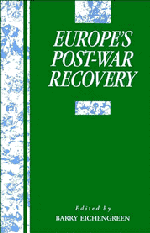12 - Post-war Germany in the European context: domestic and external determinants of growth
Published online by Cambridge University Press: 07 September 2010
Summary
Introduction
In 1945 much of Western Europe resembled an economic shambles: bombed out factories and houses, a heavily destroyed infrastructure, and raw material shortages combined with dysfunctional monies to create a grim picture of the economic future. Experts viewed a rapid recovery to prewar consumption levels as optimistic: “The probable improvements over the next five years, or even in the coming decade, are not likely to bring about a solution of the basic economic problem of Europe – the severe poverty in which the majority of the European peoples live” (United Nations, 1948, p. 212).
In retrospect, the initial pessimism was unjustified, and spectacularly so: growth rates during the first post-war decade remain among the highest on historical record. Among the recovering countries, West Germany, initially written off as an all but hopeless case, turned in one of the most impressive performances (table 12.1), rebounding sprightly from post-war depths to more than double prewar production levels by the end of the 1950s, while integrating some ten million propertyless and homeless newcomers from the East. In the contemporary view the strong recovery was all the more surprising as the German government, under the liberal economics minister Ludwig Erhard, favored supply-side policies that often were the direct antithesis of the post-war Keynesian recipe for rapid growth (Wankel, 1979; Sohmen, 1959).
“Economic miracles” are again in strong demand today as the postsocialist economies of Eastern Europe embark on the long march toward a market economy.
- Type
- Chapter
- Information
- Europe's Postwar Recovery , pp. 323 - 352Publisher: Cambridge University PressPrint publication year: 1995
- 4
- Cited by



